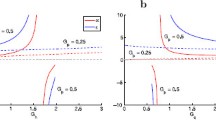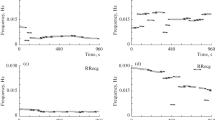Abstract
A mathematical model designed originally for pacemaker neurons and post synaptic potentials represents acceptably respiratory driving by a pump through the Hering-Breuer reflex (Vibert et al. 1981). Discrepancies with the respiratory embodiment arose firstly in the zig-zag plots of average driving and driven intervals where the boundaries between positively and negatively-sloped segments differed, and where a hysteresis-like dependence on the order of the observations occurred. Secondly, they arose from the fact that estimates of the slope A and intercept B of the linear dependence of the delay on the arrival phase of the driver differed when based on the model's formulae but using different aspects of the same data. The question thus arose as to which model shortcomings cause discrepancies with this particular embodiment.
This communication presents computer simulations that explore the consequences of modifying, or imposing variabilities, upon several parameters. A reflects how the driver's (i.e. the inflation's) consequences increase as it arrives later in the driven (i.e. phrenic) cycle: when it departs from around 0.7, (as required by the model) and approaches 1. The positively sloped segments broaden at the expense of the negatively-sloped ones which disappear when A reaches 1. The intercept B reflects the effect of the driver when it arrives just after the driven event: its increases shift a relatively unchanged plot up and to the right. When the driving period I exhibits variability or the driver one N exhibits variability or trends, as happens often with the respiratory embodiment, the model-predicted behavior remains acceptably natural-like: in particular, that with a jittery driven period mimics well observations on cats with high CO2 or superficially anesthetized. For each driving period, the driven intervals pertained to a limited number of classes (e.g. to one, two or three) which occurred in an invariant sequence.
Similar content being viewed by others
References
Benchetrit G, Bertrand F (1975) A short-term memory in the respiration centres: statistical analysis. Respir Physiol 23:147–158
Caille D, Briois I, Poujeol C, Foutz, AS, Vibert J-F, Hugelin A (1985) Brainstem unit discharges during slow and fast respiratory rhythms induced by halothane. In: Bianchi AL, Denavit-Saubie M (eds) Neurogenesis of central respiratory rhythm. Vol 480, MTP Press, Lancaster, pp 1985
Firth DR (1966) Interspike interval fluctuations in the crayfish stretch receptor organ. Biophys J 6:201–215
Hugelin A (1980) Does the respiratory rhythm originate from a reticular oscillator in waking state? In: Hobson JA, Brazier MA (eds) The reticular formation revisited. IBRO monograph series. Vol 6. Raven Press, New York, pp 261–274
Hugelin A (1985) Multimodal distribution of respiratory period suggests a multi-oscillator origin of breathing rhythm. In: Bianchi AL, Denavit-Saubie M (eds) Neurogenesis of central respiratory rhythm. Vol 480. MTP Press, Lancaster, pp 1985
Kohn AF (1980) Influence of presynaptic irregularity on the inhibition of a pacemaker in crayfish and neuromime. University of California. Doctoral Thesis
Kohn AF, Segundo JP (1983) Neuromime and computer simulations of synaptic interactions between pacemakers. Mathematical expansions of existing models. J Theor Neurobiol 2:101–125
Kohn AF, Freitas-da-Rocha A, Segundo JP (1981) Presynaptic irregularity and pacemaker inhibition. Biol Cybern 41:5–18
Moore GP, Segundo JP, Perkel DH (1963) Stability patterns in interneuronal pacemaker regulation. In Proceedings of the San Diego Symposium for Biomedical Engineering, La Jolla CA, pp 184–193
Perkel DH, Schulman J, Bullock TH, Moore GP, Segundo JP (1964) Pacemaker neurons: Effects of regularly spaced synaptic input. Science 145:61–63
Segundo JP (1979) Pacemaker synaptic interactions: modelled locking and paradoxical features. Biol Cybern 35:55–62
Segundo JP, Kohn AF (1981) A model of excitatory synaptic interactions between pacemakers. Its reality, its generality and the principles involved. Biol Cybern 40:113–126
Vibert J-F, Caille D, Segundo JP (1981) Respiratory oscillator entrainment by periodic vagal afferents: An experimental test of a model. Biol Cybern 41:119–130
Author information
Authors and Affiliations
Rights and permissions
About this article
Cite this article
Vibert, J.F., Caille, D. & Segundo, J.P. Examination with a computer of how parameters changes and variabilities influence a model of oscillator entrainment. Biol. Cybern. 53, 79–91 (1985). https://doi.org/10.1007/BF00337025
Received:
Issue Date:
DOI: https://doi.org/10.1007/BF00337025




